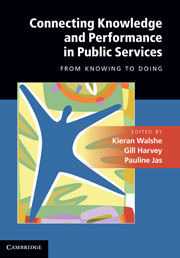Book contents
- Frontmatter
- Contents
- List of figures
- List of tables
- List of boxes
- Notes on contributors
- Foreword
- 1 Introduction: knowledge and performance – theory and practice
- 2 Knowledge from inspection: external oversight and information to improve performance
- 3 How is information used to improve performance in the public sector? Exploring the dynamics of performance information
- 4 Citizens, users or consumers: the voice of the public and its influence on improving performance
- 5 Competition and choice: the place of markets in connecting information and performance improvement
- 6 The role of corporate governance and boards in organisational performance
- 7 Change at the top: connecting political and managerial transitions with performance
- 8 The role of leadership in knowledge creation and transfer for organisational learning and improvement
- 9 Process Improvement and Lean Thinking: using knowledge and information to improve performance
- 10 Using evidence: how social research could be better used to improve public service performance
- 11 Absorptive capacity: how organisations assimilate and apply knowledge to improve performance
- 12 Knowing through doing: unleashing latent dynamic capabilities in the public sector
- 13 Conclusions: a puzzle, three pieces, many theories and a problem
- Index
- References
5 - Competition and choice: the place of markets in connecting information and performance improvement
Published online by Cambridge University Press: 05 July 2011
- Frontmatter
- Contents
- List of figures
- List of tables
- List of boxes
- Notes on contributors
- Foreword
- 1 Introduction: knowledge and performance – theory and practice
- 2 Knowledge from inspection: external oversight and information to improve performance
- 3 How is information used to improve performance in the public sector? Exploring the dynamics of performance information
- 4 Citizens, users or consumers: the voice of the public and its influence on improving performance
- 5 Competition and choice: the place of markets in connecting information and performance improvement
- 6 The role of corporate governance and boards in organisational performance
- 7 Change at the top: connecting political and managerial transitions with performance
- 8 The role of leadership in knowledge creation and transfer for organisational learning and improvement
- 9 Process Improvement and Lean Thinking: using knowledge and information to improve performance
- 10 Using evidence: how social research could be better used to improve public service performance
- 11 Absorptive capacity: how organisations assimilate and apply knowledge to improve performance
- 12 Knowing through doing: unleashing latent dynamic capabilities in the public sector
- 13 Conclusions: a puzzle, three pieces, many theories and a problem
- Index
- References
Summary
Introduction
The ‘invisible hand’ of competition is a common textbook mechanism for improving performance. Provided there is sufficient information, the autonomous choices of individuals will improve efficiency of provision. The competitive pressure consumer choice creates helps make private firms more efficient, and they cut costs and improve their goods or services in order to attract customers. Is the same true in the context of public services such as healthcare and education? It seems easy to transfer the logic to the provision of public services. Giving service users the ability to choose applies competitive pressure to public service providers and, analogously with private markets, they will raise their performance to attract (or retain) clients. The aim of this chapter is to subject this assumption to the scrutiny provided by both the theoretical and empirical economic evidence on choice and competition in the healthcare and education sectors.
Extending competition between public service providers is currently a popular policy, in the UK and elsewhere. In the UK public sector some form of competition has been present since the quasi-market reforms of the late 1980s (Bartlett et al. 1994), which emphasised competition between service providers. More recently the policy discourse has focused more on increasing direct consumer choice (Le Grand 2007). The key question we address is whether policies that promote market-like pressures create the incentives for hospitals and schools to improve their performance and, if so, under what circumstances. What may be other, possibly less desired outcomes, and why?
Information
- Type
- Chapter
- Information
- Connecting Knowledge and Performance in Public ServicesFrom Knowing to Doing, pp. 74 - 98Publisher: Cambridge University PressPrint publication year: 2010
